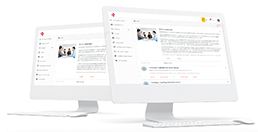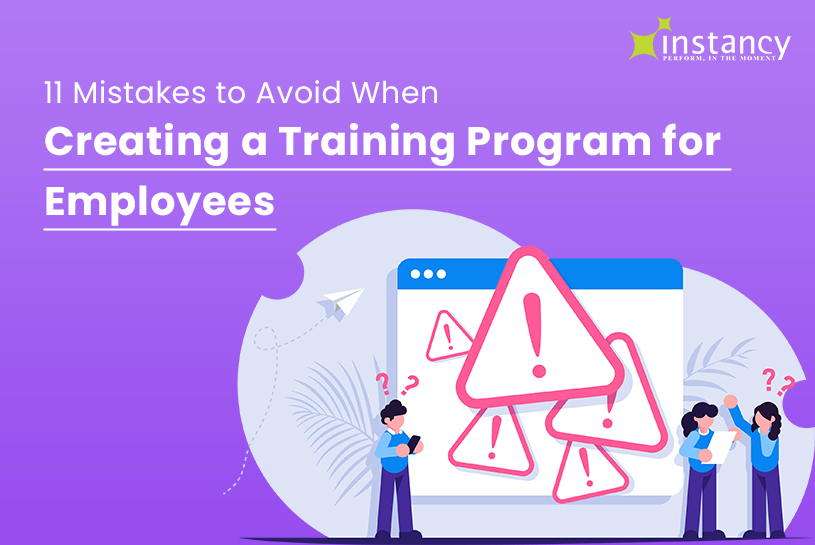Training and development for employees are commonly leveraged to enhance employee skill sets. Invariably, though there are common pitfalls that can impede training practices or training effectiveness. Safeguarding any training program against the impact of errors is of paramount importance. While mistakes do occur and inevitable in certain cases, the task at hand for the Learning and Development team is to reduce such occurrences. There are two sides to the coin of any modern training program. While on the one hand, LMS platforms offer many tools to make deploying, managing, and editing training content a piece of cake, there are several potential traps for seasoned enterprise training developers to fall into. Let’s review the most common 11 mistakes to avoid when creating a training program.
1.Misjudging the audience: Tailoring your training to the needs of the audience is perhaps key in ensuring the impact of the training program. Keeping the demographics and the mindset of your target audience will help create an approach that will result in achieving the learning outcome to its full potential. Both knowledge retention and employee engagement can go downhill in the absence of a program that is not designed to meet the needs of your target audience.
2. Irrelevance: Change is believed to be the only constant. More so in current times where training programs need to stay relevant based on new advances in technology or processes, altered perceptions, and ways of doing business. The training should strive to stay ahead of the curve, to maintain appropriate relevance.
3. Playing it safe: Being challenged by the training ensures the learner’s involvement, attention, and engagement. Keeping it easy and predictable takes away the drive to stay attentive and excel. Variety and challenges are vital strategies to consider when creating a course.
4. Missing the point: The objectives of an effective training program are expansion of knowledge, adding to understanding, boosting performance, and improving skills. Effective training should be viewed in relation to an overarching plan for skills improvement. Transitioning between points purposefully and giving learners all that they will need to follow, steers them through the training effectively. Anything that stands out as too academic, theoretical, or not in tandem with the company’s bottom line should not be included in the curriculum. While theoretical purity is a winner in the academic world, not being pragmatic is an expensive enterprise training mistake.
5. Overwhelming the participant: Heaping the training with an overload of information, based on the belief that every participant gets to pick their own take away from it is a common mistake. The better option would be to keep the learner coming back for more and stay involved and engaged in the program. The human mind can process only limited information at a particular time. A deluge of information can be frustrating and also knowledge retention takes a hit. Breaking information into small manageable chunks and paragraphs with infographics and short videos keeps it engaging.
6. Misdirecting the message: Key messaging aligned with good instructional design content is the key. Broad messaging takes away from the core topic and often leads to confusion and disinterest. The following points should be considered:
Including necessary processes and procedures
When to include important technical data
Resources that can be accessed, downloaded, and printed for later reference
When citing theoretical concepts or statistics care should be taken to include sources
7. Putting too much ”you” in your presentation: The trainer should be mindful of the participants’ knowledge and learning styles. A subjective preference in designing training modules is not necessarily well-received by all. Incorporating a media mix that spans learning styles is a safe way forward. These can include PDFs, articles, videos, and gamification. Multimedia content helps create simulated hypothetical real-world scenarios that stay with the learner.
8. Forgetting about the buy-in: The support of the upper-level management is crucial to an eLearning program. The financial commitment cannot be overlooked, whether it’s a part of an in-house training effort or meant for outsiders. whether mandatory or voluntary, participant commitment is a prerequisite for an effective training program.
9. Being disorganized or unprepared: A learning experience cannot risk glitches and ill-prepared training. This can often bite into valuable time that is at a premium for all involved. Training needs to be relevant and adhere to a schedule with infrastructure in place. This helps keep the training clean, relevant, and effective. Quality assurance should be done before launching the program officially.
10. Not validating the content: All content that is put out there for consumption needs to be checked for inconsistencies to eliminate any potential for incorrect interpretation or application. The advice of an acknowledged expert cannot be overruled.
11. Assuming that material is current and correct: Relevance and applicability of the content are crucial. While there is potentially perennial and evergreen content, checking data and information for an expiry date ensures that updates are made when necessary.
Even though mistakes are an ongoing process and there is a lot to learn from them, an understanding of the common mistakes helps eliminate the chances of keeping a training program from realizing its full potential and fast-tracking your ability to create an engaging eLearning course.
A robust Learning Content Management system can help you keep your content up to date and relevant. With cloud-based access, subject matter experts and instructional designers can collaborate to maintain the content. To learn more about Instancy Learning Content Management System, please request a demo Learning Content Management System & Authoring Tools (instancy.com).





